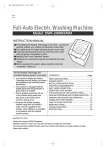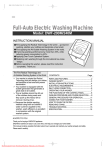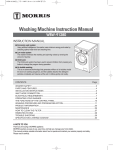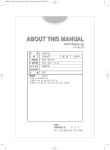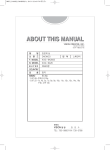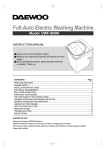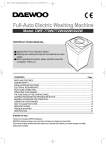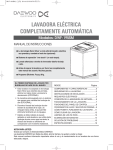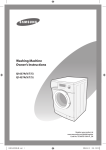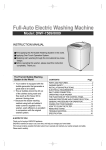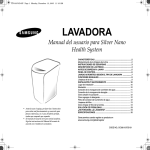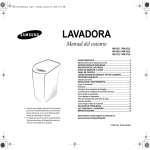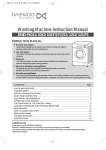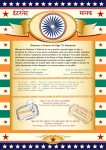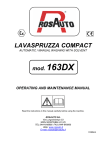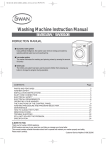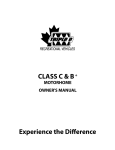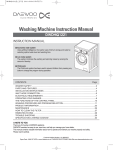Download Full-Auto Electric Washing Machine
Transcript
Full-Auto Electric Washing Machine Model: ES-D159T-SL / ES-D159T-WH INSTRUCTION MANUAL ␊ Applying the Air Bubble Washing System. ␊ Applying One-Touch Operation System. ␊ Realizing calm washing through the innovational low-noise design. ␊ Before operating this washer, please read this instruction completely. Thank you. Applying Ag+ Ion Pulsator & Air Bubble Washing System ➢ Your washer is adopted Ag+ Ion pulsator that can sterilize your clothes and deoderize bad smell. ➢ Your washer is equipped with the bubble generator that generates a great deal of air bubble. ➢ The air bubbles knock the dirt out of the clothes during wash and they push up the heavy dirt to remove it during rinse. ➢ Because the double washing method using both air bubble & water current is applied to this washer, wash efficiency is excellent in comparison with the original washer system. CONTENTS Page PARTS AND FEATURES ......................................2 WASHER SAFETY ...............................................3 INSTALLATION INSTRUCTIONS..........................4 ELECTRICAL REQUIREMENTS ...........................5 INLET HOSE CONNECTION.................................6 OPERATING YOUR WASHER..............................7 DESCRIPTION OF THE CONTROL PANEL .........8 WASHING PROCEDURE AND COURSE SELECTION ...9 GUIDES FOR OTHER USEFUL PROGRAMS ...11 GENERAL PROCEDURE FOR OPERATION .....12 WASHER MAINTENANCE ..................................13 HOW TO CLEAN THE FILTER............................14 REMOVING STAINS............................................15 TROUBLE SHOOTING ........................................16 SPECIFICATION..................................................17 A NOTE TO YOU Thank you for buying a SHARP appliance. SHARP washers are easy to use, save time, and help you manage your home better. This manual contains valuable information about how to operate and maintain your washer properly and safely. Please read it carefully. PARTS AND FEATURES The parts and features of your washer are illustrated on the page. Become familiar with all parts and features before using your washer. NOTE • The drawings in the book may vary from your washer model. They are designed to show the different features of all models coverd by this book,Your model may not include all features. • COLD WATER TAP After using the washing machine, close the water tap. • LED LAMP (option) • CASE DETERGENT AND SOFTENER • CONTROL PANEL • POWER CORD • HOSE DRAIN • ADJUSTABLE LEG ACCESSORIES WATER TAP ADAPTER INLET HOSE HOSE DRAIN (FOR NON-PUMP) USER MANUAL COVER UNDER P U 2 WASHER SAFETY Save these instructions Your safety is important to us. To reduce the risk of fire, electrical shock, or injury when using your washer, follow basic precautions including the following: Read all instructions before using your washer Please ... • Have only a qualified person install, repair, or replace parts on washer. • Maintain washer properly. • Protect washer from the weather and keep it where the temperature will not fall below freezing. • Do not install the washer at a place of extremely high humidity. It could cause an Electrical shock or a short circuit. • Connect washer to the correct outlet, electrical supply, water supply, and drain. • Ground washer properly. • Flammable fluids (dry-cleaning solvents, kerosene, gasoline, etc.) should not be used or stored in near your washer. Do not add flammable fluids to your wash water.These substances give off vapors that can create a fire hazard or explosion. • Do not allow children to operate, play with, or crawl on or inside your washer. Supervise children closely when your washer is used near them. • After starting a cycle, do not reach into the spin basket unless all motion stops. • Do not tamper with the controls. • If the supply cord is damaged, it must be replaced by the manufacturer or its service agent or a similarly qualified person in order to avoid a hazard • If the appliance is supplied from a cord extension set or electrical portable outlet device it should be positioned so it is not subjected to splashing or ingress of moisture. Understanding your responsibilities • Do not wash items that are soiled with vegetable or cooking oil. These items may contain some oil after laundering. Due to the remaining oil, the fabric may smoke or catch fire by itself. • Do not use chlorine bleach and ammonia or acid (Such as vinegar or rust remover) in the same wash. Hazardous fumes can form. • Unplug power supply cord before attempting to service your washer. • Do not wash fiber glass materials. Small particles can stick to fabrics and cause skin irritation. • Do not use hot water that temperature is over 50°C (120°F). It can cause a deformation of plastic parts. • Do not spray water on the control panel and back cover of the washer. It can cause a fire or an electric shock. 3 INSTALLATION INSTRUCTIONS Location of washer Check location where washer will be installed. Make sure you have everything necessary for correct installation. Proper installation is your responsibility. • Do not place or store your washer below 0°C (32°F) to avoid any damage from freezing. • Install the washer on the horizontal solid floor. • To reduce the risk of fire, this appliance must be fastened or otherwise secured to an uncovered concrete floor. C B A UP If the washer is installed on an unsuitable floor, it could make considerable noise, vibration and cause a malfunction. If washer is not level, adjust the front leg(A) up or down for horizontal setting. • Earthed electrical outlet(B) is required with 20cm of bottom back of washer cabinet. • Water faucets (C) must be within 1M of the upper back of the washer cabinet and provide water pressure 0.3kgf/cm2 8kgf/cm2 (0.03MPa ~ 0.8MPa). DOWN Drain system Never forget to install drain hose before operating your washer. The packing box is opened, there are a drain hose the washer. Non-Pump Model • Connect the drain hose to the drain outlet at the back of the washer. Drain hose NOTES • The opening must not be obstructed by carpeting when the washing machine is installed on a carpeted floor. 4 Non-Pump Model 1 In case that it goes over a door sill. Don’t let the height of the drain hose exceed 20cm from the bottom of washer. 2 In case of extending the drain hose. Don’t let the total length exceed 3m. 3 Be careful that the end of the drain hose is not immersed in water. 3m 20Cm ELECTRICAL REQUIREMENTS WARNING Electrical shock hazard : Failure to follow these instructions could result in death or serious injury. • Electrical earth is required on this washer. • If it does not fit the outlet, have a proper outlet installed by a qualified electrician. • Don’t earth to a gas pipe. • Don’t change the power supply cord plug. • Check with a qualified electrician if you are not sure the washing machine is properly earthed. Recommended earthing method C B A For your personal safety, this washer must be earthed. This washer is equipped with a power supply cord (A) having a earthing plug (B). To minimize possible shock hazard, the cord must be plugged into a mating earthing-type wall receptacle (C). If a mating wall receptacle is not available, it is the personal responsibility and obligation of the customer to have the proper earthed wall receptacle installed by a qualified electrician. 5 INLET HOSE CONNECTION For Ordinary Tap 1 Pull down the collar of the inlet hose to separate it from the water tap adapter. 2 Loosen the four screws properly in fitting into water tap. 3 Fit the water tap adapter into the water tap and tighten the four screws evenly while pushing up the adapter so that the rubber packing can attach to the water tap tightly. TAPE 4 Remove the tape, and screw connector B into connector A tightly. 5 Connect the inlet hose to the water tap adapter by pulling down the collar of the hose end. Connector A Connector B 6 Connect the inlet hose adapter of the hose to the water inlet of the washing machine by turning it clockwise to be fixed tightly. • Please check the rubber packing inside the inlet hose adapter of the hose. For Screw-Shaped Tap 1 Connect the inlet hose to the water tap by screwing the connector tightly. Connector Hose Rubber Packing Connector 2 Connect the connectorinlet supplied if necessary. Connector inlet Connector 3 Insert the inlet hose adapter into the water inlet of a washing machine and turn it to be fixed. . Rubber Packing Hose 6 Connector * Check the packing in the inlet OPERATING YOUR WASHER To obtain the best wahing results, you must operate your washer properly. This section gives you this important information. Preparing clothes for washing • Turn down cuffs and turn synthetic knits out to avoid pilling. • Tie strings and sashes so they will not tangle. • Treat spots and stains. (see “Removing stains” on page16) • Close zippers, snaps, and hooks to avoid snagging other items. Remove pins, buckles, and other hard objects to avoid scratching the washer interior. • Empty pockets and turn them inside out. Sorting • Separate heavily soiled items from lightly soiled ones, even if they would normally be washed together. • Separate dark colors from light colors, colorfast items from non-colorfast item. Loading • Mix large and small items in each load. Load evenly to maintain washer balance. An off balance load can make the washer vibrate during spin. • Reduce wash time when using a small load size setting. Loads with only a few small items need less wash time. • Use a large load size setting to reduce wrinkling with permanent press clothes and some synthetic knits. These items should have more room to move in the water than heavy items. (towels, jeans) • Drop items into washer loosely. Items should move easily through wash water for best cleaning and wrinkle-free results. • Load washer properly and select correct load size setting. Overloading and selecting a setting too small for the wash load can: - cause poor cleaning - increase wrinkling - create excessive lint - wear out items faster (because of pilling) 7 THE FUNCTIONS OF THE CONTROL PANEL • Press this button to turn the power 'ON' or 'OFF'. • Operation and temporary stop is repeated as it is pressed. • When you want to change course in operating; press the 'Start/Pause' button → Select the course that you want to change → press the 'Start/Pause' button again. • It can be used to select the full-automatic course. • By turning(right) the 'Program' Dial, course will be selected by following order : Auto/Fuzzy → Baby Care → Quick → Tub clean → Blanket → Wool → ... • This selection is effective for blue-jean, etc ... • Washing time, rinse times and spin time are selected automatically depend on amount of laundry. • Select the desired amount of water depending on the amount of laundry. • As the button is pressed, water level is selected by MEDIUM → HIGH → EXTRA LOW → LOW → MEDIUM → ... • It can be used to adjust washing time. • As the button is pressed, washing time will be repeated. 18 → OFF(0) → 6 → 10 → 15 → 18 → ... • Use it to change the number of rinses. • As the button is pressed, the times of rinse will be repeated. 3 times → 4 times → OFF(0) → 1 time → 2 times → 3 times → .... • It can be used to change spin time. • As the button is pressed, spin time will be repeated. 5 → 7 → 9 → OFF(0) → 1 → 3 → 5 → 7 → ... • Use it to set time reservation. • If the 'Res.' button is pressed, '2' is displayed. You can reserve it from 2 to 48 hours in advance. • Each pressing of the button advances on time delay by one hour. 2 → 3 → 4 → … → 46 → 47 → 48 → 2 → 3 → 4 → … • It can be used to adjust the wind-drying time after spin. • As the button is pressed, the wind-drying time will be repeated as following; 10 → 20 → 30 → 40 → 0 8 WASHING PROCEDURE AND COURSE SELECTION FULL AUTOMATIC COURSE 1. AUTO/FUZZY COURSE(SENSOR) ; • This selection is for general washing except extraordinary clothes. • The sensor selects properly the various kind of washing condition such as washing time, rinse times, spin time and water level. 2. BABY CARE COURSE ; • This selection is dffective for baby clothes. • Washing time, rinse times and spin time are selected automatically depend on amount of laundry. • You may select the desired water level depending on the amount of laundry. adjust to ‘Baby care’ 3. QUICK COURSE ; • This selection is useful to reduce water consumption and washing time for less dirty clothes. adjust to ‘Quick’ adjust water level, washing time, rinse time, spin time 4. TUB CLEAN COURSE ; • This selection is useful to clean the tub. • Washing time, rinse times and spin time are selected automatically depend on amount of laundry. • Washing time, rinse times, spin time, water level, and 'Res.(reserved washing)' are not selectable with Cleaning program. • You can keep the tub clean by executing Tub Cleaning once a month. adjust to ‘Tub clean’ 9 5. BLANKET COURSE ; • This selection is effective for washing heavy load(blanket, curtain, carpet, etc …). • Washing time, rinse times and spin time are selected automatically depend on amount of laundry. • You may select the desired water level depending on the amount of laundry. adjust to ‘Blanket’ adjust water level, washing time, rinse time, spin time 6. WOOL COURSE ; • This selection is effective for wool clothes. • Do not put leather clothes, or chamois clothes into the washing tub for washing. It may cause shrinkage or deformation to the clothes. • Please use the neutral detergents only. • The water level is fixed to 'Medium'. • Do not exceed the recommended amount of laundry - 1.5kg. • Only 'Medium' and 'High' water level with Wool program. • Spin time, wash time, rinse times and 'Res.(reserved washing)' are not selectable with Wool program. adjust to ‘Wool’ 10 GUIDES FOR OTHER USEFUL PROGRAMS Reservation Washing • Reservation can be made from 2 hours to 48hours. Set the reservation time Select the course Press START/PAUSE button • Wool and tub clean course cannot be reserved. • Your reservation time will show at display panel. Wash, Rinse or Spin Selection Partial process Only Wash Only Rinse Process Procedure 1 Press the Power button. 2 Set the washing time. 2 Set the washing time and rinsing time. Wash & Spin 2 Set the washing time and spinning time. Only Spin 2 Set the spinning time. Only Drain The buzzer will 4 Close the lid (door) and press the sound after process Start/Pause button. complete and power will switch off automatically. 2 Set the rinsing time. Wash & Rinse Repeat rinse & Spin after washing 3 Set the water level. Drain process is not applicable for this cycle. Please refer below for the spin function. 3 Close the lid (door) and press the Start/Pause button. 2 Set the rinsing time & spinning time. 2 Select the spinning time. 3 Open the lid (door) and press the Start/Pause button. 11 The buzzer will sound and display panel will show "LE" signal. But, the power will not turn off automatically. GENERAL PROCEDURE FOR OPERATION 1. Add measured detergent to the detergent case. (Follow manufacturer's directions for safe use) 2. OPTIONAL STEP • Pour liquid fabric softener into the dispenser using the amount recommended on the package. Avoid dripping or spilling any fabric softener on the load. • Dilute fabric softener with warm water. Fill dispenser with warm water until liquid reaches the base line in the case. The dispenser is for liquid fabric softener use only. • The liquid fabric softener will be put into the TUB automatically when final Rinse process. Inlet Hole Base Line Detergent 3. Close the washer lid (door). 4. Press the power button. 5. Select the cycle. 6. Press the “Start/Pause” button. 12 Softener inlet CARING FOR YOUR WASHER Proper care of your washer can extend its life. This section explains how to care for your washer properly and safely. Cleaning your washer Exterior Interior Wipe up detergent, bleach, and other spills with a soft, damp cloth or sponge as they occur. Occasionally wipe the outside of the washer to keep its looking like new one. Clean interior with 250ml of chlorine bleach mixed with 500ml of detergent. Run washer through a complete cycle. Repeat this process if necessary. Do not put sharp or metal object in your washer, or they can damage the finish. Check all pockets for pins, clips, money, bolts, nuts, etc. Do not lay these objects in your washer after emptying pockets. Winter storage or moving care Install and store your washer where it will not freeze. Because some water may stay in the hoses, freezing can damage your washer. If storing or moving your washer during freezing weather, winterize it. To winterize washer To use washer again • Turn off water faucet. • Disconnect and drain water inlet hoses. • Run washer on a drain and spin setting (see page 11) for 1 minute. • Unplug the power supply cord. • Flush water pipes and hoses. • Reconnect water inlet hoses. • Turn on water faucet. • Reconnect power supply cord. Non-use or vacation care Operate your washer only when you are at home. If will be on vacation or not using your washer for an extended period of time, you should: • Unplug the power supply cord or turn off eletrical power to the washer. • Turn off the water supply to the washer . This helps avoid accidental flooding (due to a water pressure surge) while you are away. 13 HOW TO CLEAN THE FILTER Cleaning the Lint Filter • This washer has two type of lint Filter in order to increase lint filtering performance. It is assembled in the middle area of Tub.(Option) 1 Pull the button with pulling upward. 2 Open the Cover and get rid of lint being the Inside of Filter then close the Cover. 3 Assemble the Lint Filter as it was, by pushing toward wall with fixing slot. Cleaning the water inlet filter • Clean the filter when water leaks from the water inlet. 1 Pull the power plug out before cleaning it. 2 Turn off the water supply to the washer and sperate the inlet hose. 3 Pull the inlet filter out. 14 4 Remove the dirt from the inlet filter with a brush. Removing stains Stained, heavily-soiled, or greasy items may need to be prewashed or soaked for best results. Soaking helps remove protein-type stains like blood, milk, or grass. Prewashing helps loosen soil before washing. Stain removal rules • Use warm water for soaking or prewashing stained laundry. Hot water can set stains. • Most stains are easier to remove when they are fresh. • Before treating any stain, find out what kind of stain it is, how old the stain is, what kind of fabric it is, and if the fabric is color fast. (Check the care label) • Washing and drying can set some stains. • Start with cold or warm water, hot water can set some stain. • When bleach is recommended, use a bleach that is safe for the fabric. • Put the stained area face down on a paper towel or white cloth. Apply the stain remover to the back of the stain. This forces the stain off the fabric instead of through it. Stain removal guide STAIN Blood Chewing gum Cocoa, Chocolate Coffee Cream/Milk Ice cream Deodorant Egg Fabric/Softener Fruit stains Grass Grease and oil Iron or rust Lipstick Mildew Mud Oil-based Paints Water-based Paints Scorch marks TO REMOVE Rinse immediately in COLD water. If stain remains, soak in cold water with an enzyme prewash. Use ice in plastic bag to harden the gum. Scrape off what you can and the sponge with white spirits. Sponge with COLD water and soak in an enzyme prewash. If stains persist, rub in a little detergent and rinse in cold water. Blot up quickly and rinse out in COLD water. Rub in a little detergent and wash in the maximum temperature allowed for the fabric type. Rinse in COLD water and wash normally. If stain is still apparent, sponge with white spirits. Rub affected area with white vinegar and then rinse out in COLD water. Sponge with white spirits. Treat stiffened areas with enzyme prewash. Soak in a COLD enzyme prewash, rinse and wash normally. Rub affected area with bar soap and wash normally. Treat as soon as possible by sponging with COLD water. Rub a little detergent on the stain and wash normally. Sponge with white spirits. Rub in an enzyme prewash and wash as normally. Lay the affected area face down on an absorbent cloth and work from the back. Sponge with white spirits or dry cleaning fluid. Wash normally. Apply lemon juice and salt and place in the sun. Wash normally. Sponge with white methylated spirits and wash normally. Wash in WARM water and detergent. Moisten area with lemon juice, dry in the sun and wash normally. If stain persists and the fabric allows, use a bleach. Brush off any dry mud. Rinse in cold water. If stain persists rub in a little detergent and wash normally. Scrape off any fresh paint and sponge with a non flammable dry cleaning fluid and wash normally. Treat while still wet, rinse in WARM water and wash normally. Dampen a cloth with hydrogen peroxide, lay it over the affected area and press with a fairly hot iron. 15 TROUBLE SHOOTING Most problems are easily solved if you understand the cause. Check the following list for problem before calling for service. Before calling for service, check these PROBLEM CHECK POINT • The washer will not operate at all. • Is there a power failure? • Is the power cord correctly connected to an electric outlet? • Is the electric fuse broken? • Did you turn on the power? • Did you press Start/Pause button? • Is there correct amount of water in the tub? • Water is not supplied; • Did you connect the inlet hose and open the water tap? • Is the inlet hose or the water tap frozen? • Is the water supply shut off? • Does foreign matter block up the inlet hose filter? If water supply is not finished within 20 minutes, the lamp will light up, and the buzzer will sound to indicate a problem. • The washer will not drain; If the drain is not finished within selected time, lamp will light up, and the buzzer will sound to indicate a problem. • The washer will not spin; If the clothes is collected on one side during spin and the tub becomes unbalanced, the spin operation will be interrupted, and then this unbalanced condition will be corrected by following operation: WATER SUPPLY ᵎ RINSE ᵎ DRAIN However if the unbalanced condition is unchanged despite repeating the above operation, the lamp will light up, and the buzzer will sound to indicate a problem. • Is the drain hose frozen or blocked up by dirt? • Is the drain hose kinked or deformed? • Is the end of the drain hose immersed in water? • Is there excessive dirt inside the pump housing? • Is the clothes in the tub collected on one side? • Is the washing machine installed on an uneven floor or is the vibration serious? • Is the lid open? (The lamp will light up in this case.) ■ These cases are not malfunctions • The sound “wing” heard during water supply is the operating sound made by the water inlet valve. • The sound “sha” heard in stopping the tub is the sound that comes from the autobalancer of the tub. • The sound “wung” heard during wash or spin is the operating sound made by the air bubble generator. NOTE Please check the point before calling for a service. If the supply cord is damaged, it must only be replaced by a repair shop appointed by manufacturer, because special purpose tools are required. 16 SPECIFICATION MODEL NO. ES-D159T-SL / ES-D159T-WH POWER SOURCE 220V/ 50Hz POWER CONSUMPTION 550W Dimension (WxHxD,mm) 630 x 1040x 700 Unit Weight 48 kg Standard Water Consumption 240ὀ Operating Water Pressure 0.3kgf/cm2 ~ 8kgf/cm2 (0.03MPa ~ 0.8MPa) Wash Mode Washing Type (Air-Bubble + Ag+ Ion Pulsator) NOTE • In case of moving Washing Machine, please follow the following picture. 17 Front Top ABOUT THIS MANUAL vision@creativeL@incN Էܞ ړĸ ࣃۉʷ VѨێ ݖΟӂ˱ Tࠚ ɽ ʁ ъ ڜܞɮ Ҹ ͗ ˝ sharp fN@model dwfMRVPnpmcmT bN@model esMdQUYtMsl@O@esMdQUYtMwh b@u@y@e@r ࢚Ĺॶ ܆ ॥ ࣽ ض ې ش լ ٙش ࠾˝ memo@܂րZ@H߭ QWI QTNPRNRPMहݖL@QW@@֭Ŕ R QTNPTNRSMहݖL@XL@YL@QPL@QQ@ր֭@܄Ŕ U@Hێ࢛ٝ ɮI QTNPTNSPMTL@UL@X@ր֭@܄Ŕ S@Hێ࢛ٝ ɮI QTNPUNPRMTL@VL@QW@ր֭@܄Ŕ S@Hێ࢛ٝ ɮI QTNPUNRPMRL@VL@XL@QRL@QW@ր֭@܄Ŕ U QTNPUNRSMRL@TL@QW@ր֭@܄Ŕ S QTNPUNRWMXL@YL@QPL@QQHϴҸͭېѽĈIր֭@܄Ŕ THێ࢛ٝɮI QTNPUNRXMX@ր֭@܄Ŕ QHێ࢛ٝɮI QTNPVNQVMXL@YL@QPL@QQHϴҸͭېѽĈIր֭@܄Ŕ THێ࢛ٝɮI ِ͊ߏ vision ɽ ʁ і О ր telZ WSPMPVVP@faxZ WSPMSWXX


















